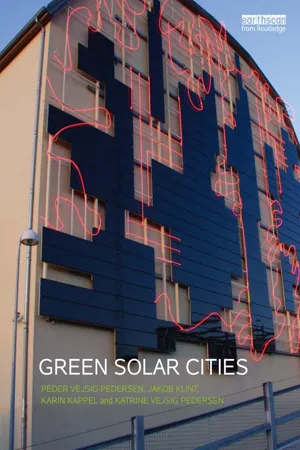
Green Solar Cities
- 316 pages
- English
- ePUB (mobile friendly)
- Available on iOS & Android
Green Solar Cities
About This Book
The Green Solar Cities, EU-Concerto project focuses on the practical large scale implementation of solar energy technologies in combination with new build and retrofit low energy building in the cities of Copenhagen, with its city part Valby, in Denmark and Salzburg in Austria. This book aims to influence decision makers in European cities towards a similar approach to the Green Solar Cities project, in close cooperation with leading building component suppliers, energy companies and engaged builders also working with local city officials.
This book will benefit those in a situation where many cities aim at a "Smart City" development, but without clear policies of how to achieve that in practice. In Denmark there are similar policies, with an overall aim to be CO2 neutral by year 2025 in the city of Copenhagen. However, there is still a lack of understanding concerning, how solar energy as the world's number one energy source can play a major role here and how this can be combined with energy efficiency policies, use of district heating and combined heat and power.
The general aim is to introduce the international "Active House" standard and work on "Active Roofs" of the future. The connection between solar energy and low energy building and energy renovation is aimed to be ensured by help of the "Active House" standard which has been developed in cooperation with a number of leading building component manufacturers in Europe.
Frequently asked questions
Information
Chapter 1
Solar Energy in Cities
Green Solar Cities: EU Concerto project

PV art at ‘Prøvehallen’ gable in Valby, which can be seen from the railway, is a symbol of the Valby PV plan. Photo: Anders Sune Berg.

The PV gable in daylight. Photo: Anders Sune Berg.

Buffer tank for solar thermal energy in the Lehen area of Salzburg.

New-build with solar collectors in Lehen, Salzburg.

Solar collectors and a buffer tank are part of a low-temperature micro grid. Photo: SIR (www.sir.at)

Active House specifications.

The director of the ‘Lynette Cooperative’ Torben Knudsen was a driving force of the plan to realise the Damhusåen PV plant, here also supporting the large-scale PV plant for Valby.

Photo of the Damhusåen PV plant in Valby, which by January 2013 was the largest PV plant in the Nordic countries. It covers 8 per cent of the electricity at the Damhusåen waste water treatment plant, which is owned by the ‘Lynette Cooperative’ in Copenhagen (now Biofos). It is supplementing biogas-based electricity production to cover almost 50 per cent of yearly electricity use by renewables.

Photo from a large housing retrofit project in Valby at Hornemannsvænge housing estate: 14kWp of PV (100m2) and 100m2 of solar thermal is used for each of six renovated housing blocks.
Table of contents
- Cover
- Half Title
- Title Page
- Copyright Page
- Table of Contents
- Preface
- Introduction
- 1 Solar Energy in Cities
- 2 Solar City Copenhagen
- 3 Green Solar Cities
- 4 Energy-Efficient Buildings
- 5 Visions
- 6 Smart Solar Cities
- Photographer list
- Bibliography
- Index